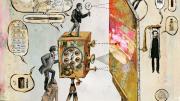Call them art detectives. Using scientific methods, the researchers at the Fogg Museum’s Straus Center for Conservation and Technical Studies gather evidence and help solve art mysteries: Who painted this? What materials did the artist use?
One such mystery involves the self-taught American artist James Castle. Profoundly deaf, perhaps autistic, he never learned to speak or write. He lived in rural Idaho, creating compelling, intimate works, including hundreds of drawings using only woodstove-soot mixed with his own saliva. He sketched with color as well, and assembled three-dimensional figures from bits of packaging. His work was still largely unknown outside Idaho when he died in 1977 at the age of 78.
Flash forward three decades. Conservators wanted to know where Castle obtained his pigments, what tools he used, and how he worked. Castle’s family had provided some clues, through artifacts and memories. For more precise information about certain pieces, Daniel Kirby, an associate in conservation science at the Straus Center who has a background in biotechnology, used an instrument common in biology but fairly new to art conservation: a laser-desorption-ionization time-of-flight mass spectrometer. The technique is often called LDMS, for short.
In one analysis, Kirby tested a single fiber of yellow paper from a Castle drawing, using the instrument’s laser to ionize the pigment molecules. (Pigment ionizes easily.) The resulting ions “flew” to the instrument’s analyzer, with smaller ions traveling faster than heavier ones, enabling a detector to determine each ion’s mass by its time of flight, measured in billionths of a second.
The method produced a “mass spectrum,” a distribution pattern of the ions’ masses. When Kirby and his associates compared the patterns to those of known pigments, they found three matches in the single fiber. By comparing these pigments to those identified in materials known to come from Castle’s studio, the team discovered intriguing evidence about the color sources and techniques the artist may have used: green tempera paint and a yellow wax crayon—both perhaps applied to paper using a piece of chartreuse fabric.
Narayan Khandekar, senior conservation scientist at the Straus Center, says that this new analytical technique has dramatically expanded conservators’ ability to identify materials that artists use in contemporary art. Until Kirby tried LDMS, Khandekar says, “we had hit a dead end” in identifying complex modern organic pigments. Recently, for example, the center was able to determine that a Jackson Pollock-style painting likely was not a Pollock; LDMS identified a pigment in the painting that had been developed after Pollock died.
Kirby says LDMS is useful for identifying mixtures of pigments, even when they’re blended with binders and other inorganic materials. He also believes, because of the simplicity of sample preparation, that LDMS is easier to use than other available methods. He wants to publicize the practice and has begun teaching it to visiting conservators from other institutions. “What we’re trying to do is develop simple turnkey techniques that nonexperts can do,” he explains. (For several years, Kirby used an instrument at Harvard’s chemistry and chemical biology mass-spectrometry facility on Oxford Street. Last March, after he gave a talk at the Waters Corporation on his use of LDMS, the company donated one to the Straus Center. “We’re the only conservation lab on the planet that has its own,” he says.)
He has also used the instrument, in a slightly different process, to identify paint proteins more precisely than previously possible—not just egg binder, for example, but egg white, specifically from a chicken, rather than a duck. In a Mark Rothko mural owned by Harvard, Kirby found that the artist had used both egg white and yolk in his paint, a combination that produces a particular sheen. “The choices an artist makes are incredibly important,” Khendakar says. “We’re now able to get in there and tell in great detail what those choices were.”
Daniel Kirby e-mail address:
Straus Center for Conservation website:









